Image Details

Photograph courtesy of Scala/Art Resource, N.Y.
Most of the biblical account of Moses’ life deals with his role as a public leader appointed by God, but Sandro Botticelli’s 15th-century fresco, painted on a side wall of the Sistine Chapel, depicts the more personal events from the first chapters of his life (Exodus 2:1–4:20).
Moses appears seven times and is clearly identifiable by his bright gold clothes and dark green cloak. At the far right, two figures watch as Moses attacks the Egyptian taskmaster; perhaps they are the spies who will report the deed to Pharaoh. Above this scene, Moses can be seen fleeing to Midian, where (at bottom center) he encounters Zipporah and her sisters at the well. He sends away the troublemaking shepherds (center) who had been bothering the young women and waters the girls’ sheep. Moses’ first encounter with God, at the burning bush, is depicted in two episodes at upper left. The right-hand scene shows him removing his shoes because he stands on holy ground; just to the left, Moses kneels before God as he emerges from the flames. On the far left, Moses takes his family—his two sons and his wife Zipporah, in the blue dress—with him as he returns to Egypt, at last prepared to follow God’s command and free the Hebrew slaves.
